Social media is one of the most important channels to reach new customers and maintain a positive brand image. Social media can help you increase brand awareness, customer loyalty, and revenue.
This guide reviews some fundamentals of creating your brand image on social media, helping you with hacks, real-life examples, and actionable advice. Keep reading below!
Table Of Content:
-
The Why/What
1. Social Media Isn’t Everything
2. Know Your Audience
3. Use The Right Selling Point
4. Use The Right Form
You can directly jump to a section of your choice or keep scrolling.
The Why/What
This first section is probably what you're here for because it's where we discuss the hacks promised in the title, analyzing their mechanisms and why they work. But if you want to know how to implement them, you'll have to stay tuned for the next section ("The How").
Without further ado, let's start with the most important one:
1. Social Media Isn’t Everything
Using social media to create and maintain a positive brand image is a smart move. Firstly, almost everyone is using it today. Look at these stats:
- There are 4.6 billion active social media users
- 147 minutes is the daily time spent on social media per day by a user
Secondly, social media is proven to attract attention, raise engagement, and increase sales. Besides, it's cheaper than most other paid media, bringing you an impressive ROI. Again, the numbers speak for themselves:
- 88% of marketers noticed increased exposure from social media
- 79% benefited from increased traffic
- 69% got more leads
- 61% developed loyal fans
- 60% improved sales
However, social media isn't a magic wand that can help you sell anything. First, you must ensure that your products and services respond to your customer's most pressing needs.
Phone Loops is an excellent example.
The company manufactures actual phone loops that people can attach to their smartphones. The purpose is to keep the phone secured to users' hands when taking selfies.
Identifying this problem was highly insightful. Many young people take photos or selfies in all sorts of situations – not just in front of the mirror.
Young people want to immortalize everything from safaris to morning jogs or swimming. And Phone Loops can help them not smash their phone screens while doing that. Or drop them into the water, like in the following clip:
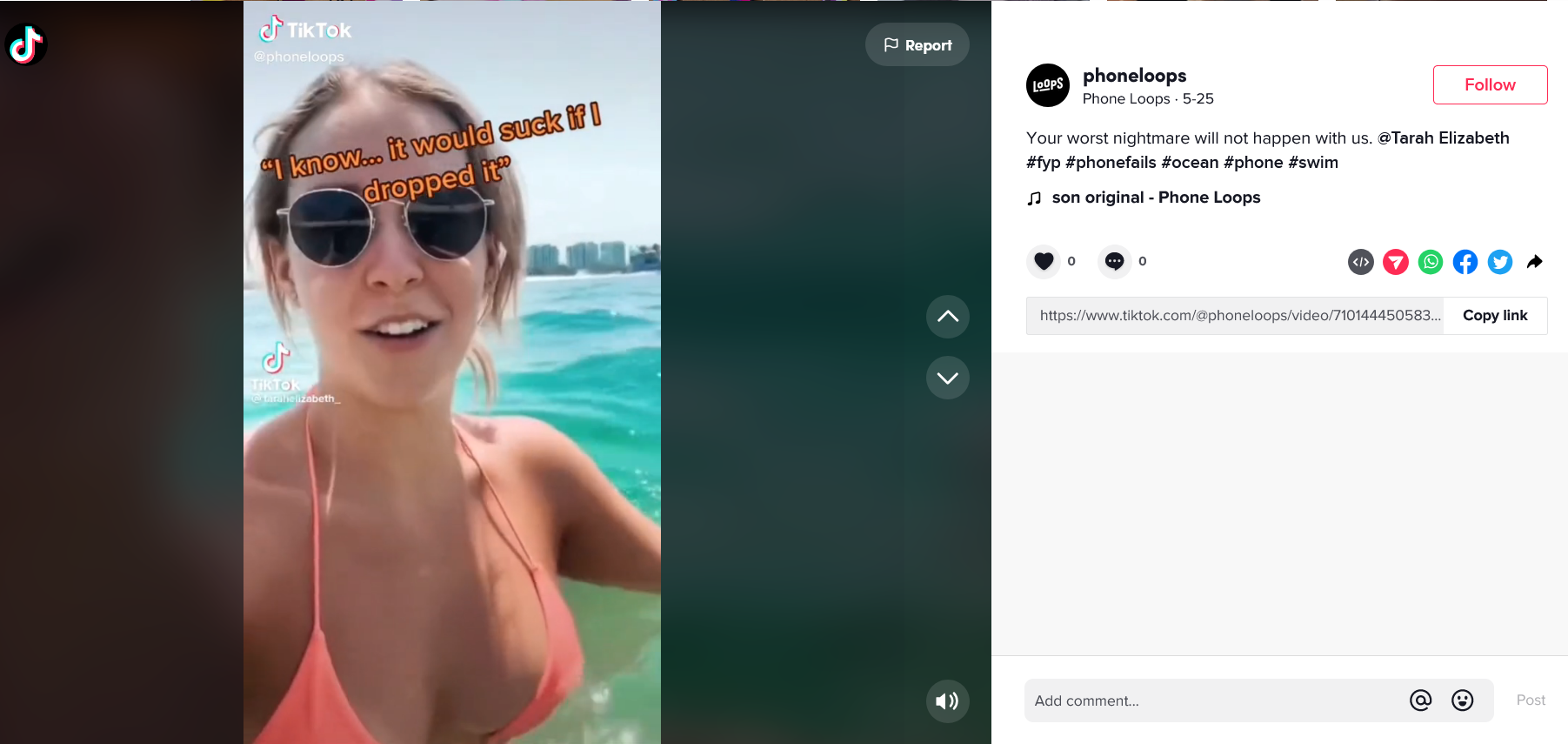
Image Source: TikTok
After identifying this problem, Phone Loops successfully used social media to educate their audience and create desire. However, the important part is they had an intuitive product to start with.
Note: Every company can produce and deliver good products today thanks to improved equipment, production, and logistics.
That's why you need an insightful product and a unique selling point that sets you apart from the competition. Next, you'll have to leverage social media so that potential customers find out about your products, recognize their advantages, and purchase them.
2. Know Your Audience
Imagine having the best product, much like Phone Loops in the previous example, then marketing it to the wrong audience.
You can't please all the people all the time – but you can please some of the people sometimes, and that's what branding is all about. Knowing your target audience is the first step toward creating and maintaining a brand image.
Understanding who your target market is, what they want, and how they want it delivered is crucial to fashioning a brand image that resonates with them and should be part of every project plan. That means you'll know everything from the most appealing colors and fonts to intricate insights like the most convincing keywords or CTAs.
Research is essential here – but we'll discuss it in "The How" section below.
3. Use The Right Selling Point
Social media is filled with brands trying to advertise themselves one way or another. Facebook has received many complaints about becoming too monetized, and Instagram is not far behind.
Things are even worse if customers feel overwhelmed by the ads surrounding them on social media. People open social media to unwind in the privacy of their own homes – or work cubicles. Intrusive ads spoil that fun and damage brands' images.
There's a solution and it all starts with the keyword "intrusive."
An ad (in the largest possible sense that includes all brand messages) isn't perceived as invading if it's relevant to the target audience. Or if your audience actively seeks it.
That's why you have to use the right selling point for your audience. You'll have to rely heavily on the previous issue here: understanding your customers before speaking to them.
Milla Lachi, a Brazilian fashion house, offers an excellent example of leveraging social media to convey the right selling point that helps create the right brand image.
Milla Lachi starts from this insight:
- People often purchase clothes and accessories without having a defined style. So, although those items look good on the shelves and are so-called "fashionable," they won't compliment the wearers.
- Milla Lachi understands that a clothes brand must do more than simply sell those clothes. It has to educate the audience on color schemes, accessories, looks, body shapes, and more.
That's why the brand publishes these short clips on its social media.
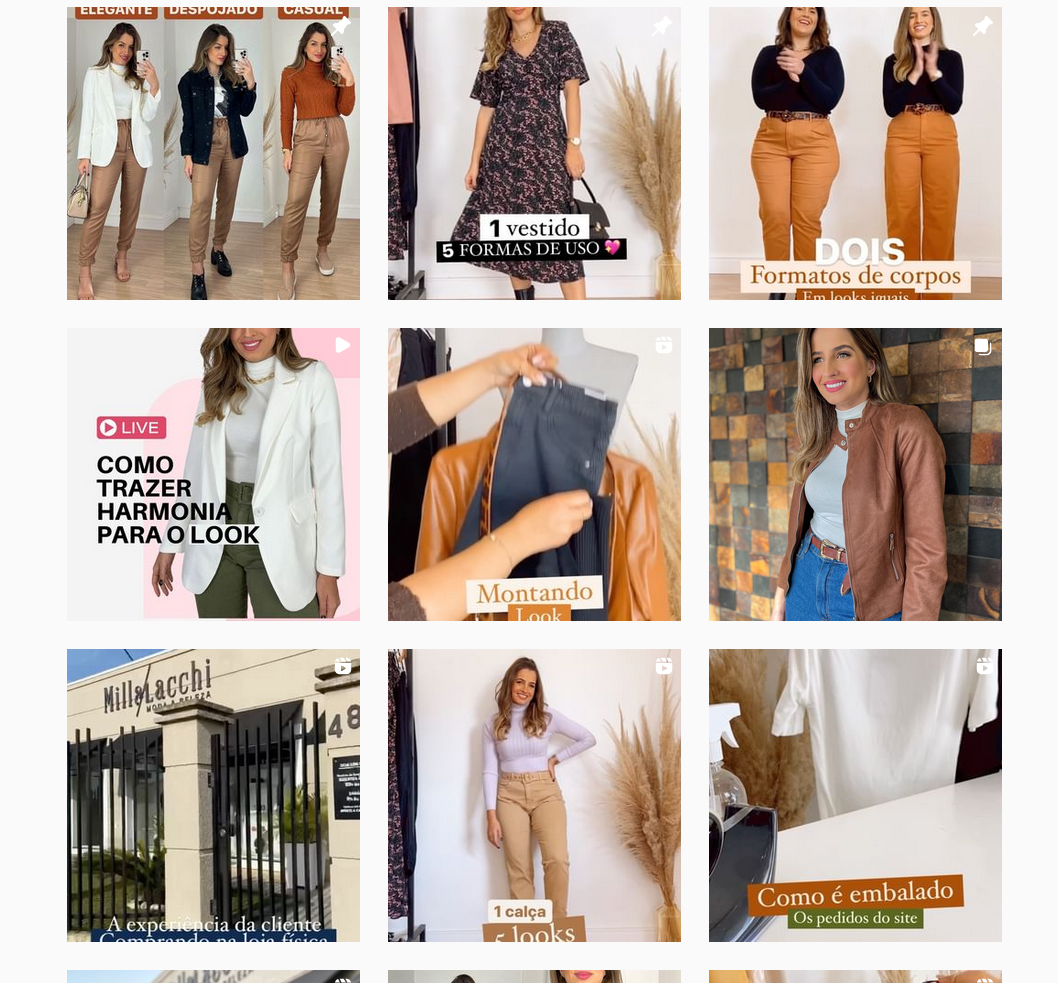
Image Source: Instagram
The results are multifold:
- People don't see these brand messages as intrusive because they're relevant, teaching them valuable information.
- The brand builds expertise and credibility before selling.
- Publishing these tips daily helps people remember the Milla Lachi as a place where they can get clothes and fashion tips.
- Using different items in these clips helps the brand present its products without being intrusive. That's because the clothes are seemingly in the background, being used as practical tools to attain a specific look. At the same time, this strategy creates desire.
And depending on your company, it's very possible to simply offer something for free in the hopes of a potential customer joining your business. Compared to trying to sell something directly on social media, this can be a wonderful solution for those who can take advantage of it.
An example would be a SAAS company.
They might create informational social media posts that call for users to listen to their podcast to hear insights/strategies to improve their business. Then, on the podcast, they can use webinar software to hold a bi-weekly or monthly webinar that’ll help them.
While the sales cycle is slower with tactics like this, it helps build trust and credibility that extends beyond social media.
4. Use The Right Form
Once you have the right substance, you have to dress it in the right form. This point entails several other variables:
- Use the right social media channel, namely the one your audience uses. And that brings you back to the second point – understanding your potential customers.
- You have to adapt your message to the channel. For example, TikTok is best for short-form clips, while Instagram is best for eye-catching visuals. If you need a video explaining your products' features in-depth, use YouTube or Twitch.
- Pick the right format. Ads are sometimes essential on social media to funnel potential customers towards product pages. But other times, you may need an influencer, employee, or expert speaking on your behalf. That also means associating yourself with the right individuals who share your brand's values.
Bryan Millar Walker offers an interesting example. Founder and tour guide at Distinct Scotland, Bryan is also a passionate photographer.
He markets Distinct Scotland on two leading social media channels: Instagram and TikTok. Although he published two videos on YouTube in 2021, Bryan isn’t active on the platform currently. Here's why:
YouTube is better for long-form videos, and Bryan is better at creating condensed, short clips. These clips pack touching music, awe-inspiring (and highly edited) images, and his very charismatic presence. As such, they can elicit intense and varied emotions.
Although Bryan uploads almost the same videos on Instagram and TikTok, you can notice some differences:
- Instagram is highly organized, featuring just the presentation clips Bryan created. You can see in the screenshot below how well he structures those videos in different categories and the expressive thumbnails.
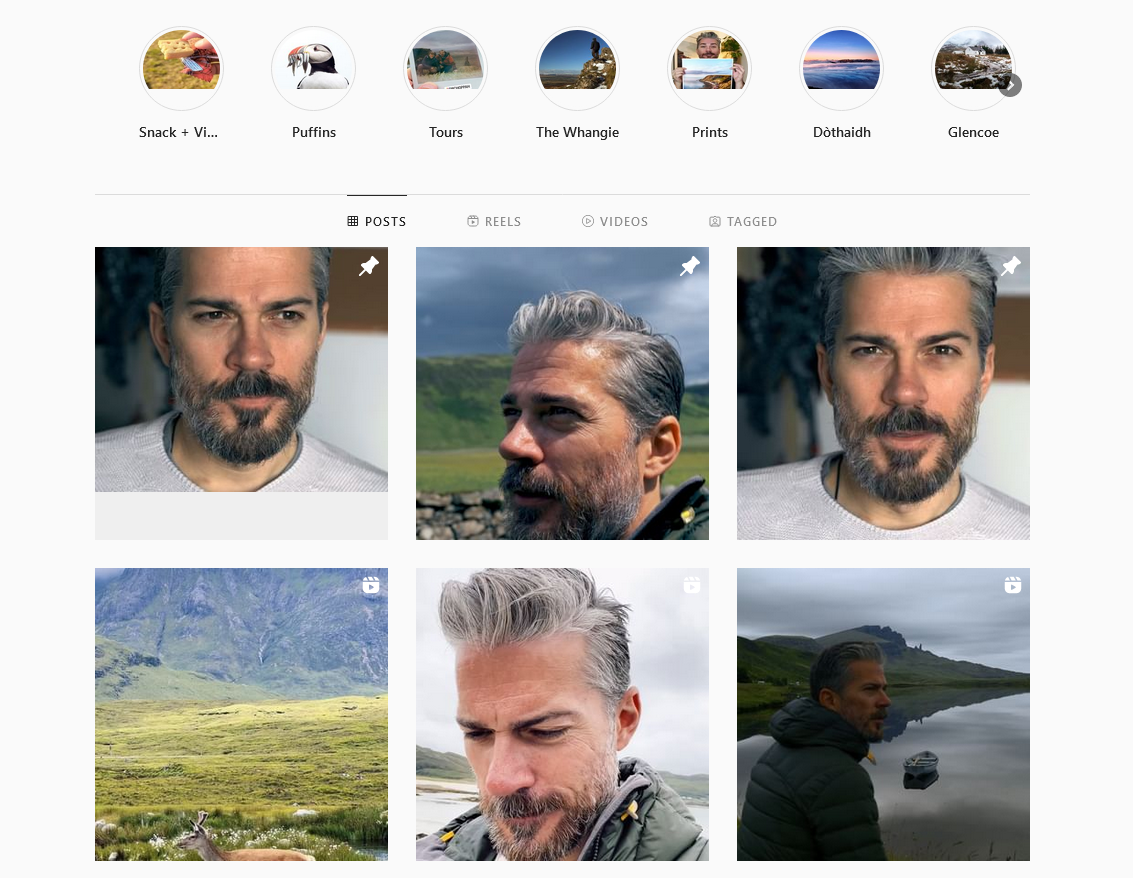
Image Source: Instagram
- TikTok offers more options to interact with its audience. In the video below, Bryan answers one of his followers' questions:

Image Source: TikTok
In this one, a follower duets with one of his clips with the caption "Someone finds me this man":

Image Source: TikTok
With that in mind, TikTok's duet option is extremely useful for creating and maintaining a brand image. Your followers can contribute, share, and transform your clips, making them viral.
However, you need a unique selling point or a hook they can use.
In Bryan's case, it's his looks and soothing documentary-presenter-like voice. People who duet his videos try to look like him.
Sometimes, you just need to dress your unique selling point in a bit of sass, like Wendy's is doing apropos of McDonald's:
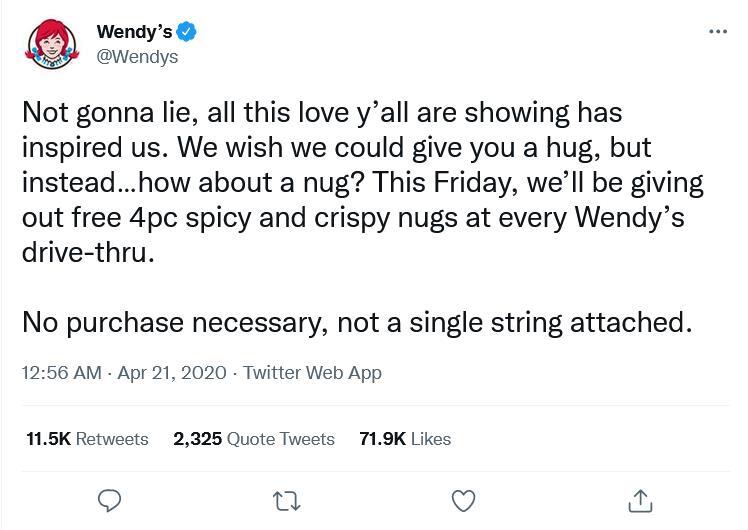
Image Source: Twitter
The How
Now that you've seen a few fundamental strategies for implementing and keeping your brand images, let's see "the how" of it.
1. Engage with Your Audience
Engagement is an important way to create and maintain a positive brand image. We didn't include it as a tip in the section above because it's more than a hack; it's a brand philosophy. It's the equivalent of healthy eating for brands. Here's why:
1. This strategy helps ensure your product is what your audience needs.
Of course, you'll have to conduct extensive quality checks, market research, and reevaluations first. But you can also leverage social media, engaging with your audience to figure out what they need.
For that:
- Use several automated tools to gather feedback and insights from social media.
Ask direct questions. - Include polls and surveys in your reels or posts.
- Read your comments carefully and reply to them, engaging directly with your audience.
2. Engaging with your audience helps you understand what messages appeal best to them. As a result, you'll be able to define a unique selling point.
Are they looking for valuable content, or are they more interested in fun and entertaining posts? Do they prefer long-form blog posts, or do they prefer short and sweet tweets? By understanding what your audience wants, you'll be able to create content that appeals to them and helps you achieve your business goals.
Replying to comments is also a good strategy.
Any marketer who's ever had a Facebook argument knows that social media can be a minefield. But while it's easy to get caught up in the drama, there's also value in engaging with your audience on social media for instant feedback.
And when it comes to understanding what messages appeal best to your audience, there's no substitute for real-time data.
Of course, not every comment is going to be constructive.
But paying attention to the overall tone of the conversation, you can get a pretty good idea of what's resonating with your audience and what's falling flat. So the next time you're tempted to ignore that vitriolic tweet, remember that it might just be worth your while to engage.
Take Fitness Blender as an example.
The fitness company started as a husband-and-wife venture. The two initially created free fitness videos for an audience who doesn't like or have the time to go to the gym. They also offered paid 4-week or 8-week training plans to sustain their company.
Fitness Blender leveraged this engagement to flourish their company to a premium version with more fitness trainers, paid workout videos, and free workout plans for the paid membership.
Here's how:
- They asked questions on social media at the end of each workout video. Their followers left tons of feedback, saying what they like, what could be improved, and what they'd want to try next.
- They facilitated this feedback by presenting themselves as run-of-the-mill, average people. Then, they lived up to this image by interacting with their fans and disclosing some personal stories. The new trainers they hired kept the same line.
Here's an Instagram post with Kelli's bloopers during one of her workout videos, which of course, also links to that workout:
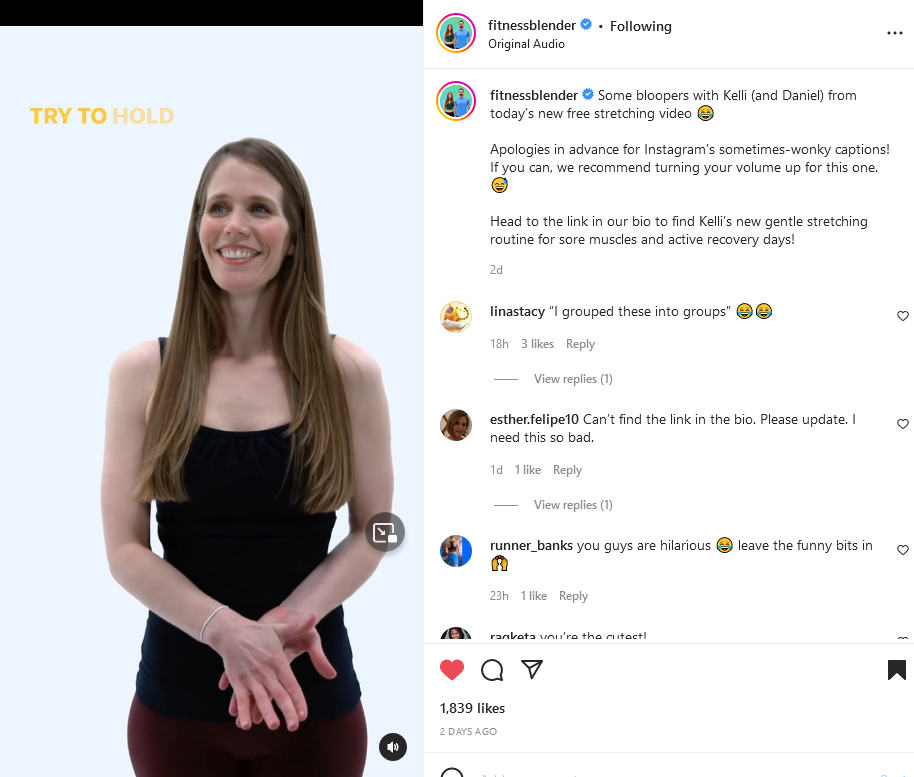
Image Source: Instagram
Notice the lack of make-up, bling, and props, which creates a very down-to-earth image. The other trainers do the same thing:
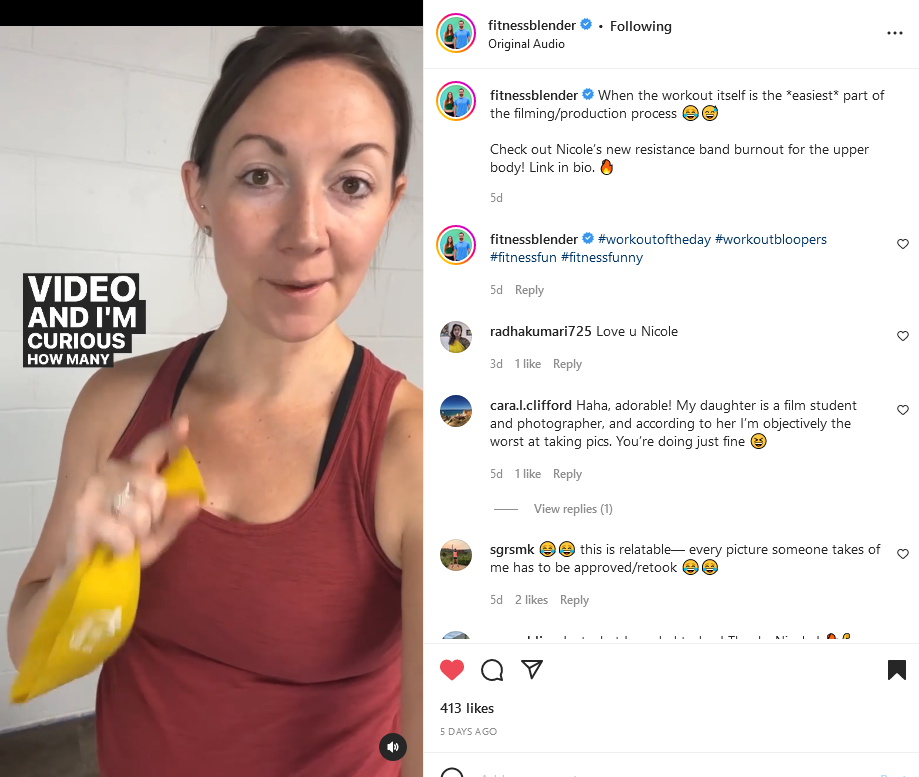
Image Source: Instagram
Notice how Nicole asks people how many tries they think she needs for her cover photo. This question instantly makes followers react and respond with personal stories.
In the video below, trainer Kayla explains the benefits of stretching but also asks her audience what moves they struggle with so she can create better routines:
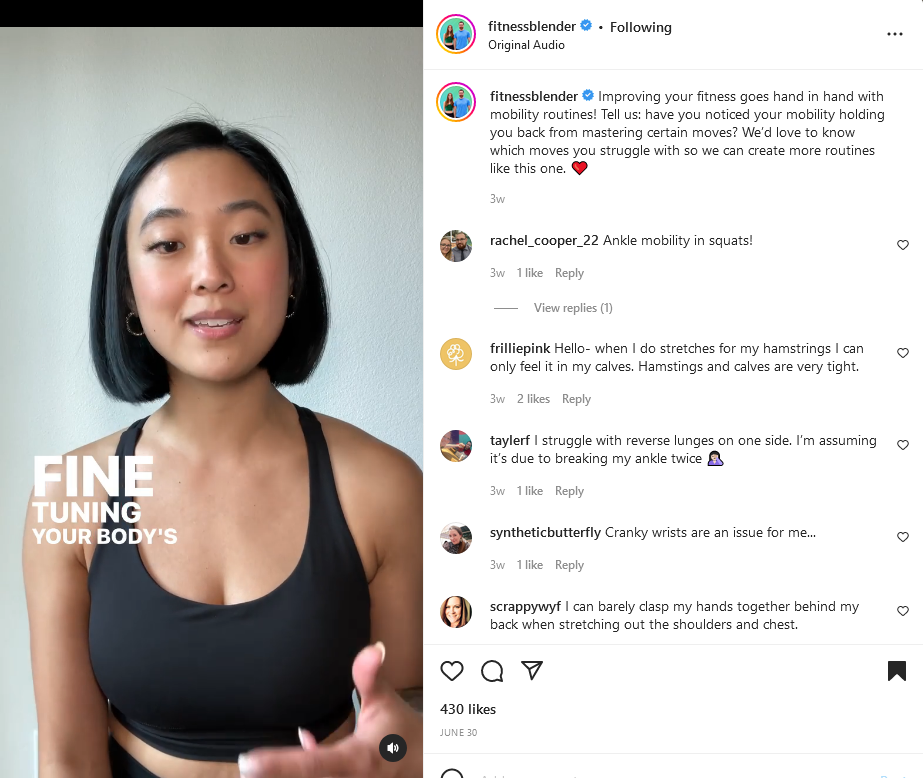
Image Source: Twitter
2. The Logistics
Engagement is the most important part of creating and maintaining a positive brand image on social media. Once you've honed that, the rest will follow, such as:
- The precise words, images, links to product pages, and CTAs
- The colors and fonts
- The content creators you partner with
- The replies
- The automation tools
Creating your content vs. using an agency is another critical issue. If you're unsure where to start, an agency will help you devise the right strategy and steps to reach your goal.
You don't have to be a marketing newbie.
For example, a TikTok ads agency will help you connect with the right content creators and devise the right form for your relevant content, leveraging the current trends.
Thinking About Incorporating Statusbrew?
Engaging with each customer individually will help you gain excellent insights, but it takes a lot of time. Building customer personas and brand personas is also useful but time-consuming. Besides, these strategies aren't exact.
That's why more marketers use automated social media tools like Statusbrew.
It assists you throughout your campaign, from publishing your first posts to reviewing your results. It helps you derive precise insights into your audience, measuring your results against your KPIs and managing your team communication from a single dashboard
Statusbrew's Engage does not just sync conversations from different social platforms but also automates conversation. It even lets you filter out the irrelevant comments from your comments section to avoid destroying your brand image online.
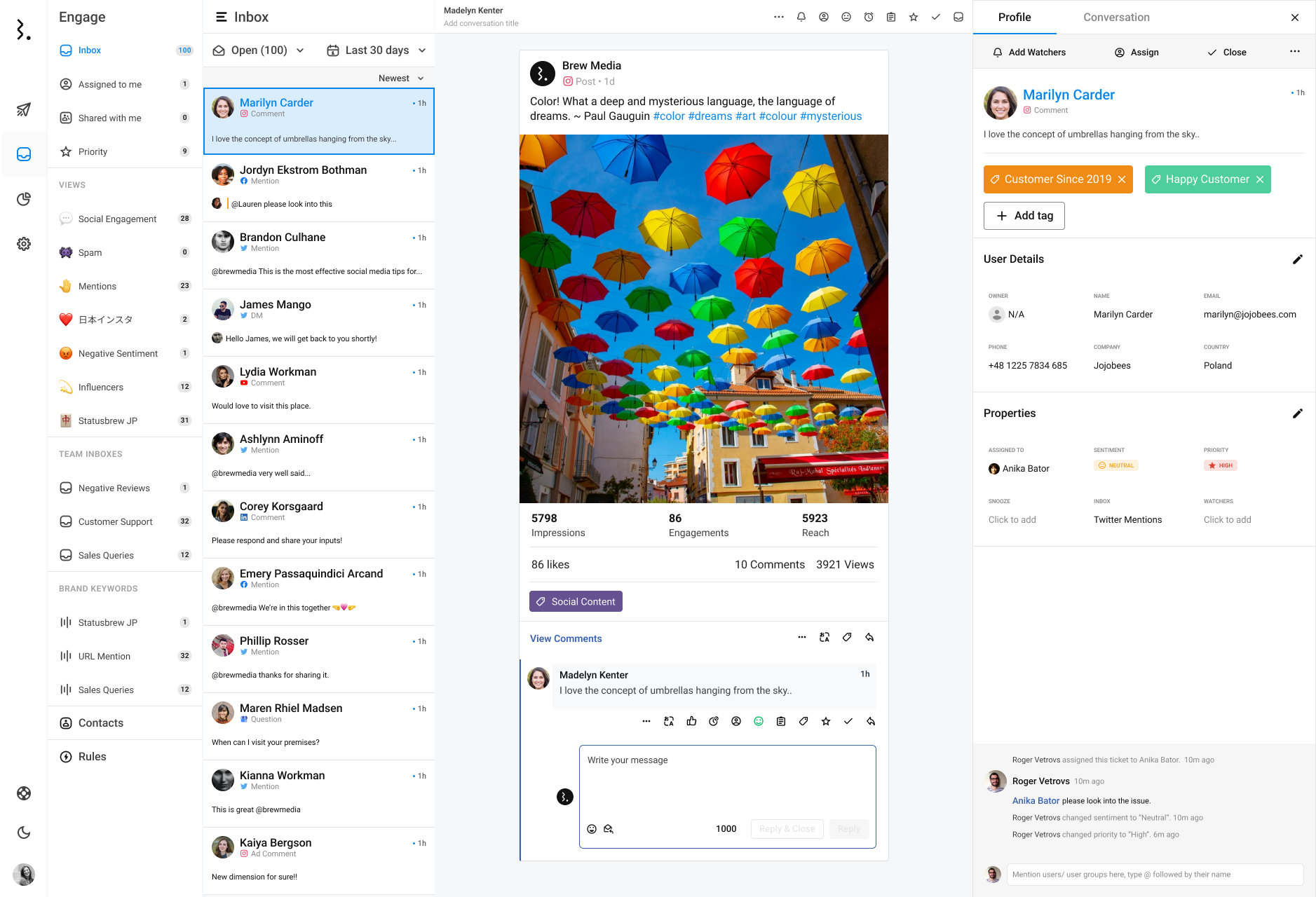
Key Factors Involved
As you can see, the key factors involved are:
- Your product: It has to be high-quality and, most importantly, helpful to your audience.
- Your audience: You want to listen to them, engage with them, and use their feedback to improve your products and communication.
- Your messages: You want to stay relevant and memorable. That means using the right channels, words, questions, visuals, and sound effects.
Conclusion
The hacks we discussed aren't quick fixes; they're strategies and mindsets that will guide you regardless of your brand. By now, you might have learned to focus on your product and audience, leveraging social media as a tool.
Remember the many successful brands that made it when social media didn't even exist?
Offering a relevant solution to people's problems, practicing social listening, using the right software, and partnering with the right agency are the true hacks keeping you ahead of the competition. And even better, they're evergreen regardless of any new social media channel or trend that can arise.
And remember that if you want to manage your social conversation effectively, efficiently, along with your team, Statusbrew can offer you one of the best solutions.
Statusbrew is an all in one social media management tool that supports Facebook, Instagram, Twitter, Linkedin, YouTube, and even Google My Business.




Explore the Statusbrew range of social media tools
Cancel anytime!